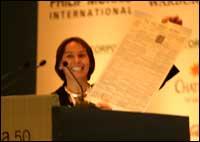|
|
| Help | |
| You are here: Rediff Home » India » Business » Interviews » Christine Brendle, MD, Wall Street Journal Asia |
|
| ||||||||||||||||||||||||||||||||||||||||||||
|
| ||||||||||||||||||||||||||||||||||||||||||||
Christine Brendle had come with the perfect prop.
Sharing the dais with India's prime minister to inaugurate a conference on India's emergence as an economic power, the managing director of The Wall Street Journal Asia and The Far Eastern Economic Review began her opening remarks holding aloft the August 15, 1947 edition of The Wall Street Journal.
'India's Freedom From Britain Offers Hope of More Trade With US' read the lead headline written almost 60 years ago. Today, America is India's biggest trading partner and is the largest investing country in India in terms of Foreign Direct Investment approvals, actual inflows, and portfolio investment.
Titled 'Driving Business -- India's New Priorities, Asia's New Realities' the conference organised by the New York-based Asia Society in Mumbai included the Wall Street Journal as one of its co-organisers.
Brendle joined the Journal this February, following a 17-year career with the Hachette Filippachi publishing group in Asia, the US and Europe.
In a conversation with Assistant Managing Editor Archana Masih, she discussed the Wall Street Journal, its online position as the largest paid subscription site and the upcoming redesign of the newspaper in America.
Rupert Murdoch has said that power is moving away from the old elite of the newspaper industry in the age of the Internet. What do you think about the future of newspapers?
People are always going to be reliant on brands because they trust them. Therefore, with the Wall Street Journal we have to be ready to reach the consumer wherever he is going to look for us -- whether in print or online.
Therefore the integration between print and online was a necessity and that is how we came with the compact launch (the Wall Street Journal's European and Asian editions were relaunched in tabloid form) last October.
We are making a very definite effort to integrate the two platforms and to communicate to all the consumers interested in the Wall Street Journal franchise that the two platforms exist and are really complimenting each other. I am sure there will be competitors following suit.
Five years down the line, how many readers do you think will read the Wall Street Journal in newspaper format and how many online?
 I am a great believer that print will not disappear. The two medium will continue to evolve and reinforce each other because there are times I am delighted to read the paper and there are times I am delighted to be able to consult it online. It just expands the experience you have with the franchise and the brand.
I am a great believer that print will not disappear. The two medium will continue to evolve and reinforce each other because there are times I am delighted to read the paper and there are times I am delighted to be able to consult it online. It just expands the experience you have with the franchise and the brand.
Personally, I am convinced that ten years from now there will a great audience that will be consulting us online but I don't think this will make the print edition disappear.
The Wall Street Journal is a broadsheet in America and appears in the tabloid format in Europe and Asia, what impact has it had on the readers? How has it helped the paper?
In India we launched in October and we have seen the number of new orders increase in the last quarter of 2005, so that was an initial good sign. A lot of new orders came through people who were getting this combination of online and print, online. That was a confirmation that we were tapping into people who were online users and were receptive to the new offer we were presenting to them.
The other thing we have seen is an advertising increase -- the last quarter of 2005 was strong. Internally we were asking if it was because we had a marketing campaign, was it long lived or short lived, and it has been very encouraging to see that the revenue in the first quarter of 2006 is strong. We believe that the success of the compact is there.
How much it is going to influence America, frankly, I think the plans have very much been mapped up for the Wall Street Journal with the revision of the look of the paper and the preparation of a version of the paper that is going to be slightly narrower. That is planned for 2007. We are building on it internally in the company in the States. A lot of the fundamentals that we wanted to achieve with the launch of the compact are going to be pursued further in the States.
How is the Wall Street Journal going to attract more young readers? How is it going to win the battle of the young reader?
When we look at the profile of our readers we have the traditional print readers. We have seen with the compact that the new orders a lot of time come from online. We are attracting a young audience.
In a market like India where the print possibilities for us are somewhat constrained, we are looking at the online. Probably only online is going to basically position the franchise of the Wall Street Journal and possibly the Far Eastern Economic Review.
What changes has the Wall Street Journal made in trying to be more appealing to the young reader?
The Wall Street Journal has a mission of informing investors. What we are constantly trying to do is ask ourselves -- how can we help provide people with what they are looking for in a trustworthy, accurate and very authoritative way. Whether they are young or old, this is pretty much what we are trying to do.
Our weekend section is for a broader audience. This will help us attract a slightly wider audience, probably younger but not necessarily.
How is the reader in Asia different from the American or European reader?
The American newspaper (the Wall Street Journal's US edition)is a slightly different animal. It has been established in America for so, so long. It is an institution and has a large circulation, it is the largest paid web site. But the readers really share a lot of similarities -- in Europe, America and Asia -- they are terribly wealthy, in high positions in the organisations they work for, so you are talking to people who are influential in the enterprises that they lead and who have wealth to invest.
Since the Wall Street Journal is a subscription site do you think this has affected its reach? Doesn't Forbes online have more readers online than the Wall Street Journal?
Today we are the largest paid web site and from an advertising point of view it has been a winning strategy. It meant that people who were paying for our site had a relationship with the franchise and you have a qualified audience. You chose not to get clicks by chance but because people want to go to this site and get information. So as a strategy it has worked beautifully.
We are at the beginning of developing a marketing plan for the site outside of America. It has been so successful in America that there has been very limited effort to promote it abroad. Now with the new reorganisation of the company, this is something we will do and I suspect that the subscription base is far from having sealed. We are going to see further growth.
Could you elaborate on your online plans in Asia?
Continue to promote the print and online combo. Promote it online which we haven't done very much in Asia. We are looking at two major markets -- India and China -- and see how can we position ourselves online with all the online properties we have -- the various products we have in-house. What is the best approach to tackle this market and make a presence in it with our expertise online. This is what we are going to do in the next few months.
Do you think the new rulers of the media will be Google or Yahoo and not old media players like your company Dow Jones or The New York Times?
I don't think so. When people get on Google or Yahoo or when they get on the Net, they need a beacon. They need to have guidance and Dow Jones and its brands like Far Eastern Economic Review, Wall Street Journal, Market Watch, Barron's they provide immediate information on what content people expect and the trust people have in this content.
Sometimes online you can get an encyclopaedia that tells you things that are blatantly wrong. It helps to have these brands because they are a guarantor for quality and therefore I am absolutely convinced that they will stay and grow online because they will present the same benefits that are in the print which is a certain guarantee of integrity and quality.
Photographs: Jewella C Miranda
More Interviews|
|
| © 2008 Rediff.com India Limited. All Rights Reserved. Disclaimer | Feedback |